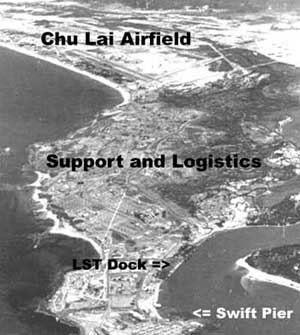
Arial View of Chu Lai Combat Base
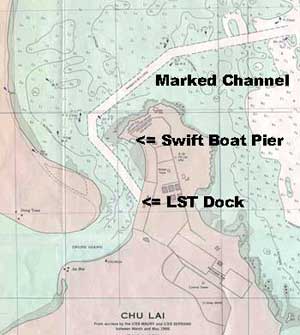
Marked Channel Entrance to Chu Lai Harbor
| Chu Lai |
| Coastal Division 16 |
 Arial View of Chu Lai Combat Base |
 Marked Channel Entrance to Chu Lai Harbor |
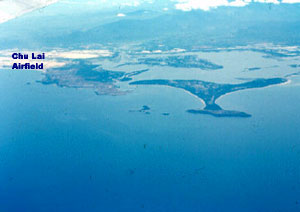 Chu Lai Harbor |
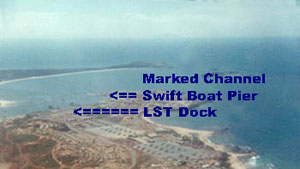 Naval Support Activity Chu Lai |
|
 A small city: The Army-Marine-Navy Base at Chu Lai |
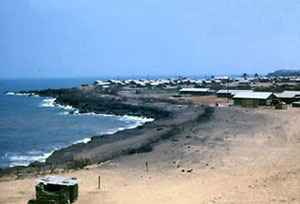 The Swift Housing Quarters on Rosemary Point |
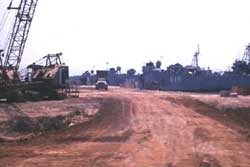 |
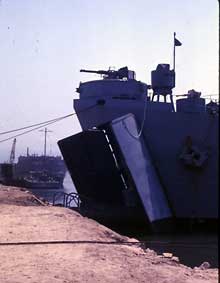 |
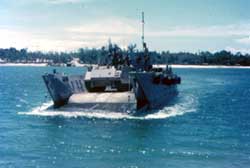 |
The primary US Navy activity at Chu Lai was the logistics support for both the Marine Air Units and Army Americal Division. This was accomplished by material offloading of supplies from LST and other small cargo vessels proceeding from the larger ports at Da Nang, Qui Nhon and Cam Ranh Bay. The provisions for the Swift Boat contingent formed a minor portion of that material support. |
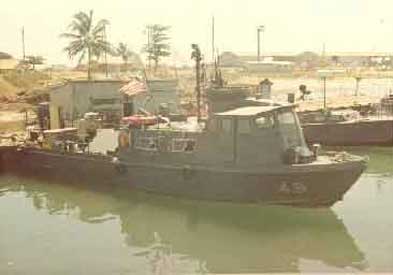 |
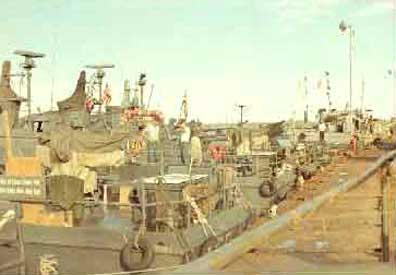 |
In early June 1967, PCF 45 was the first Swift Boat to be transferred from Cam Ranh to the newly forming CosDiv 16
at Chu Lai. After the long trip north, we entered the narrow marked channel, turned abruptly left into the rock bordered
shallow waters at the tip of the spit head entrance, and tied up stern first to the Swift Boat pier.
|
The white sandy beaches of Cam Ranh Bay had been replaced with the fine red dust and more noticeable presence of barbed wire and sand bagged bunkers in Chu Lai. The naval facilities on the spit of land at the harbor entrance were probably just as secure as those at Cam Ranh. And living conditions while off patrol, although sparce, were no less comfortable. But the general feeling was more "warlike." As we found out, this matched the activity going on in the patrol areas around and north of Quang Ngai. |
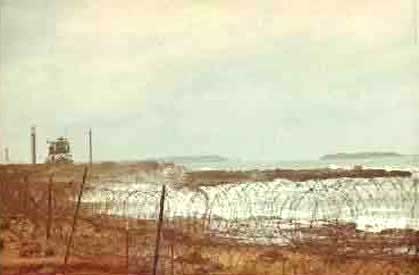 |
 |
We were also caught in the middle of some minor administrative confusion common to any new entity: As we arrived, there was some doubt about the command structure for the new division, which was still in the process of being formed. Were we a separate detachment of CosDiv 14 reporting to Cam Ranh? On temporary duty with the CosDiv 12 detachment already there? Or were we truly part of a new organization separate from both? Eventually, a Commander for the new division was assigned from Da Nang, and Coastal Division 16 became a reality and not just an idea. Concurrent with this activity, the assimilation of our crew, and those that followed us from Cam Ranh, was accomplished quite readily and we very quickly got into the normal cycle and rhythm of operations. The enthusiasm existent in the new organization, along with a much higher tempo of activity in the area, was contagious. But we never really quite reached a point where we felt we were part of the first team of old hands from CosDiv 12. Regardless, we were there to do a job, and so we got on with doing just that ... by going on daily patrols and letting events ashore sort themselves out. |
 |
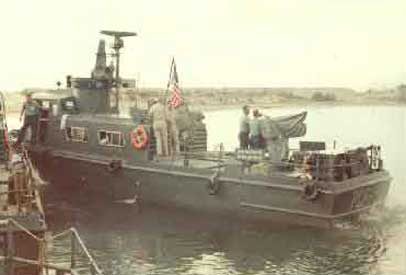 |
|
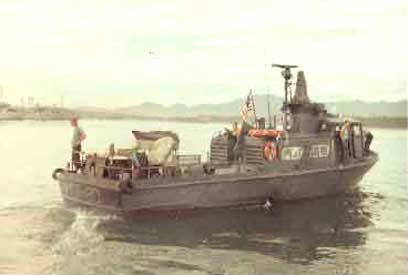 |
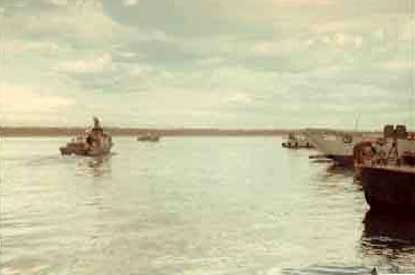 |
Another aspect of our move north was that it was to a region where the "Sea Services" were dominant rather than the US Army. I Corps was the purview of the Third Marine Amphibious Force (III MAF), the commander of which was also the I Corps Commander. This made decision turn around on such tactical issues as indirect fire support much smoother. It also meant that logistics support was supplied directly by the Navy. |
Even though the Marine Division in our area had recently been relieved by "Task Force Oregon" - soon to be the re-formed 23rd (Americal) Infantry Division - the Naval Support Activity Detachment at Chu Lai was still in full swing. The naval base facilities reflected this, with the SeaBees and supply folks doing a quite credible job providing a few amenities to our small portion of the much larger military presence at the base. Including a very nice chapel and a Fleet Post Office in Chu Lai. Both were very important morale boosters. | < | 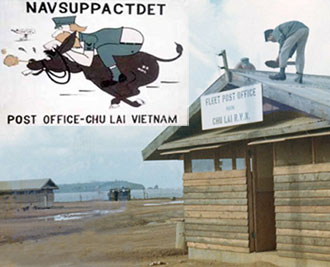 |
A young supply Ensign assigned to the NSA Det, by the name of Roger Staubach, was often seen playing catch with a football in off duty hours on the open field (called Staubach Stadium) next to the chapel. One of our crew even heard him remark as his receiver scrambled toward the sanctuary: "Watch this 'hail mary' toss I am perfecting. I may just find a use for it some day ... perhaps against the Vikings!" |
 |
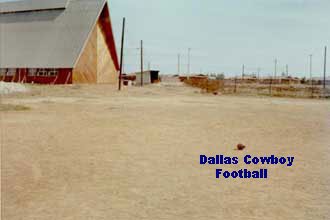 |
|
| Image courtesy of Terry Jelcick {Just kidding Roger} |
"Officer's Country" at CosDiv 16 consisted of "duplex hooches" with from four to six Swift Boat "skippers" sharing each side of the duplex. But since half of the junior officers were on patrol at any one time, it might be days or even weeks before one would again be in touch with other occupants of a particular berthing area. The SeaBees also provided modified metal storage barrels that made nice barbeque pits for "roll your own" alternatives to the mess hall fare. |
 |
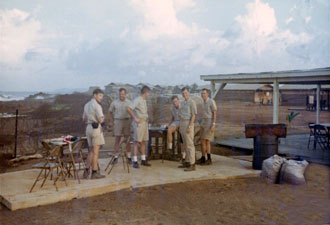 |
One facility that definitely was "not" provided by the SeaBees, was the Coastal Division 16 Junior Officer's Club. Use of a spare "hooch," midnight requisitioning of materials, including a green US Army blanket, and plenty of sweat equity soon resulted in a place where un-winding from the stress of the southern patrols could be practiced as only young americans know how. Not exactly as elegant as the Taj Mahal at Qui Nhon, but pride of accomplishment and ownership overcame any such insignificant flaws. |
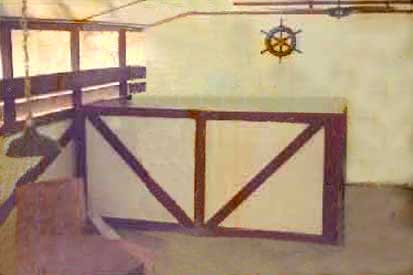 |
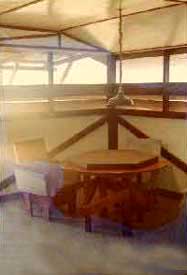 |
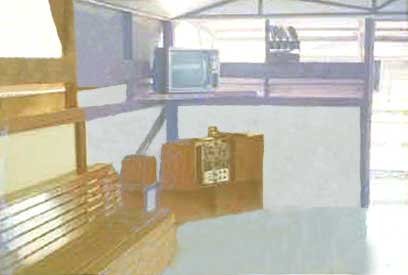 |
The serious side of the Swift Boat operations in Chu Lai were centered around the CosDiv 16 headquarters building and the local coastal and harbor operations center with its radar keeping tabs on both Dung Quat Bay and the inner harbor. |
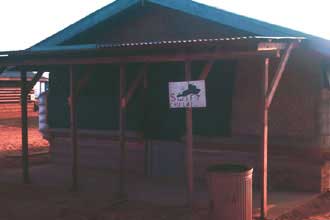 |
 |
Pride, and a strong desire to accomplish the tasks we had come to Vietnam to perform, was what Coastal Division 16 and the individual Swift Boat crews in it were all about. The division insignia shield outside the enlisted barracks was strong evidence of this enthusiasm. Despite the restraints imposed on the crews from equipment shortcomings, and the pressure made to conform to traditional naval tactics, the members of the division were determined to take the conflict to the enemy in an area where we knew he was, and where we could make a significant difference ... close in to the coastline and rivers near Quang Ngai and Mui Batangan. No pussy footing platitudes here: The ace of spades, the South Vietnamese flag, and the skull said it all ... !! No Quarter !! |
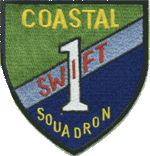 |
 |
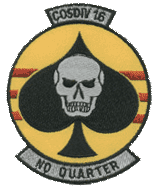 |
|
|
{Listen to his voice in the Hearts & Minds and the Rules of Engagement sections}
|
"See-Bee-Yah-Boo-Tah"
The following set of photos result from a guestbook entry by Bill Bachstet, who was with the CB {Construction Battalion}
detachment at Chu Lai from October 1966 to May 1968
He and three of his cohorts came into possession {by surreptitious means} of two A4D airplane drop tanks from the nearby air field,
and "stealthily" designed and constructed the latest and greatest way to slip up on the "wily cong" at Batangan unannounced. I am
sure that the project was designated "top secret" and all work was accomplished in the CB Detachment Chu Lai "Skunk Works."
To make a long story short: the designers were a little too strong in the hull stoutness department and a little too weak in the
marine propulsion and good seamanship areas.
|
The words "Chu Lai" are not Vietnamese, but a Mandarin Chinese abbreviation for the family name of US Marine General Victor Krulak,
who selected the area around Dung Quat Bay for construction of an air field and base to supplement the major facility at Da Nang.
When told by his staff that the area had no name associated with it on the maps of the day, he immediately decided that it would be
called Chu Lai. Rank has its privileges.
The new Vietnamese government has continued to maintain both the facility and its name
They also have very agressive plans to develop the area as described below. Currently, access to the area is restricted, but the following
two images, taken in the year 2002, show the main gate entrance to the area and the still beautiful view of Dung Quat Bay.
|
This web site is Copyright � 2002 by Robert B. Shirley. All rights reserved. Click on image to return to the homepage
|